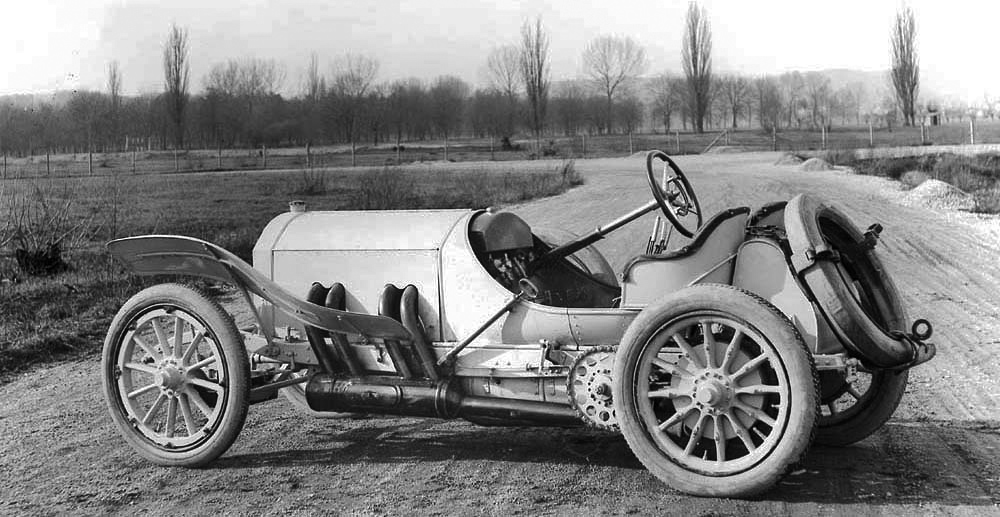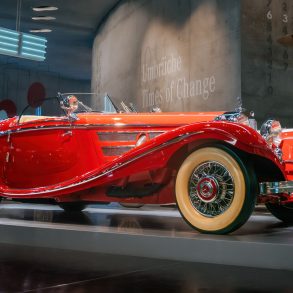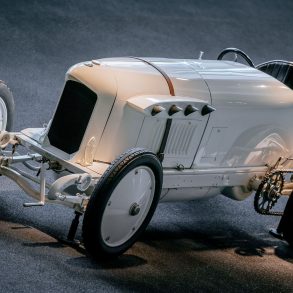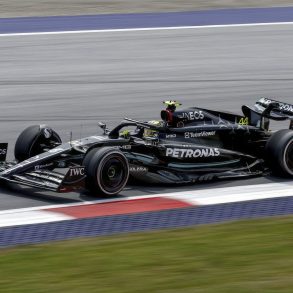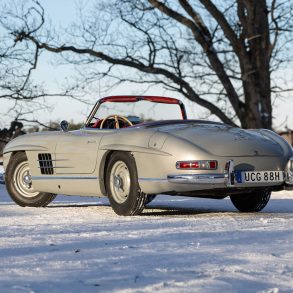Mercedes 1908 GP
Car: Mercedes 1908 GP / Engine: 4-Cylinder In-line / Maker: Mercedes / Bore X Stroke: 155 X 170-180 mm / Year: 1908 / Capacity: 12,781 cc / Class: Grand Prix / Power: 135 bhp at 1,400 rpm / Wheelbase: 270 cm / Track: 140 cm / Notes: A combination of foot brake and hand brake that acted on the back wheels slowed the vehicle down while the 4-speed gear box and chain drive kept it going. The Michelin supplied tires were 875 mm x 105 mm in the front and 895 mm x 135 mm in the rear and pressured to 100 p.s.i.!
In the early part of the 20th century automobile racing development was driven by the quest for ever larger engines for a given weight of car. What you ended up with was a motor, a chassis, seats for the driver and mechanic and not much else. Motors with capacities of 13.5 litres were being made to fit in 1,000 kg cars and raced at speeds nearing 100 miles per hour.
After running a fuel consumption formula the previous year the rules for the 1908 Grand Prix season stipulated a minimum weight of 1,150 kg., calculated without coolant, fuel, spare tires and mudguards, but including lubricant and finally a maximum piston area of 117 sq. for 4 cylinder cars and in. which limited the maximum bore to 155 mm. These new regulations forced designers to be more efficient and saw output exceed 10 h.p. per litre for the first time.
According to Robert Dick in his wonderful book, Mercedes and Auto Racing in the Belle Époque stated that the new regulations also partially mitigated the engine misfiring due to self-ignition. The earlier gigantic pistons were glowing, being unable to dissipate heat quickly enough through the cylinder walls.
William Maybach had left the firm in 1907 and the responsibility for creating a new car was given over to Paul Daimler who had earlier returned from the Austrian branch of the firm. Daimler did not stray far from the tree and created a design that followed practices that were established by Maybach earlier. The new car was built much lower to the ground and the hood line was in turn lowered by the repositioning of the radiator. With these cars Mercedes was able to triumph at the French Grand Prix over their German and French rivals with Christian Lautenschlager taking the laurels.
Their victory might have been due more to preparation than outright speed giving that many of the other racers suffered from chronic tire problems. In fact Lautenschlager’s mount was down to it’s last set and another puncture would have spelled doom. At the end of the season the cars were sold off to rich patrons and continued to compete in various events. Modifications were made and one model was to attain 180 bhp. Driven by the veteran driver Camille Jenatzy this race car was clocked at 107.5 mph over a kilometer during the Ostend Week sprint events.






